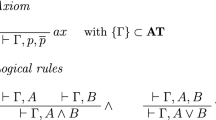Abstract
The \(\Omega \)-rule was introduced by W. Buchholz to give an ordinal-free proof of cut-elimination for a subsystem of analysis with \(\Pi ^{1}_{1}\)-comprehension. W. Buchholz’s proof provides cut-free derivations by familiar rules only for arithmetical sequents. When second-order quantifiers are present, they are introduced by the \(\Omega \)-rule and some residual cuts are not eliminated. In the present paper, we introduce an extension of the \(\Omega \)-rule and prove the complete cut-elimination by the same method as W. Buchholz: any derivation of arbitrary sequent is transformed into its cut-free derivation by the standard rules (with induction replaced by the \(\omega \)-rule). In fact we treat the subsystem of \(\Pi ^{1}_{1}\)-CA (of the same strength as \(ID_{1}\)) that W. Buchholz used for his explanation of G. Takeuti’s finite reductions. Extension to full \(\Pi ^{1}_{1}\)-CA is planned for another paper.
Similar content being viewed by others
References
Akiyoshi, R.: Complete cut-elimination theorem for \(\Omega _{\mu +1}\)-rule. (2011, preprint)
Akiyoshi, R.: An ordinal-free proof of the complete cut-elimination theorem for \(\Pi ^{1}_{1}\)-\(CA+BI\) with the \(\omega \)-rule. (2013, preprint)
Arai, T.: A subsystem of classical analysis proper to Takeuti’s reduction method for \(\Pi ^{1}_{1}\)-analysis. Tsukuba J. Math. 9(1), 21–29 (1985)
Buchholz, W.: The \(\Omega _{\mu +1}\)-rule. In: Buchholz, W., Feferman, S., Pohlers, W., Sieg, W. (eds.) Iterated Inductive Definitions and Subsystems of Analysis: Recent Proof-Theoretical Studies. Lecture Notes in Mathematics, vol. 897, pp. 188–233. Springer, Berlin (1981)
Buchholz, W.: Explaining Gentzen’s consistency proof within infinitary proof theory. In: Gottlob, G., Leitsch, A., Mundici, D. (eds.) Proceedings of the 5th Kurt Gödel colloquium on computational logic and proof theory, vol. 1289, pp. 4–17. Springer, Berlin (1997)
Buchholz, W.: Explaining the Gentzen–Takeuti reduction steps. Arch. Math. Logic 40, 255–272 (2001)
Buchholz, W., Schütte, K.: Proof Theory of Impredicative Subsystems of Analysis. Monographs 2. Bibliopolis, Naples (1988)
Gentzen, G.: Neue Fassung des Widerspruchsfreiheitsbeweises für die reine Zahlentheorie. Forschungen zur Logik und zur Grundlegung der exakten Wissenschaften. Neue Folge 4:19–44 (1938) (English translation in [14])
Girard, J.-Y.: Proof Theory and Logical Complexity, Vol. I of Studies in Proof Theory. Bibliopolis, Naples (1987)
Mints, G.: Effective cut-elimination for a fragment of modal mu-calculus. Studia Log. 100, 279–287 (2012)
Mints, G., Stüder, T.: Cut-elimination for the mu-calculus with one variable. Fixed Points Comput. Sci. 77, 47–54 (2012). (Open Publishing Association)
Howard, W.A.: A system of abstract constructive ordinals. J. Symb. Logic 37, 355–374 (1972)
Pohlers, W.: Proof-theoretical analysis of ID\(_{\nu }\) by the method of local predicativity. In: Buchholz, W., Feferman, S., Pohlers, W., Sieg, W. (eds.) Iterated Inductive Definitions and Subsystems of Analysis: Recent Proof-Theoretical Studies. Lecture Notes in Mathematics, vol. 897, pp. 261–357. Springer, Berlin (1981)
Szabo, M.E. (ed.): The Collected papers of Gerhard Gentzen. Studies in Logic and the Foundations of Mathematics. North-Holland, Amsterdam (1969)
Takeuti, G.: Consistency proofs of subsystems of classical analysis. Ann. Math. 86(2), 299–348 (1967)
Takeuti, G.: Proof Theory, Volume 81 of Studies in Logic and the Foundations of Mathematics, 2nd edn. North-Holland, Amsterdam (1987)
Yasugi, M.: Cut elimination theorem for second order arithmetic with the \(\Pi ^{1}_{1}\)-comprehension axiom and the \(\omega \)-rule. J. Math. Soc. Jpn. 22(3), 308–324 (1970)
Author information
Authors and Affiliations
Corresponding author
Additional information
The main result of this paper was obtained in 2011. After Professor Mints’ passing away in 2014, this paper was completed by the first author. He would like to express his deep gratitude to Professor Mints for collaborations including this joint work.
Rights and permissions
About this article
Cite this article
Akiyoshi, R., Mints, G. An extension of the omega-rule. Arch. Math. Logic 55, 593–603 (2016). https://doi.org/10.1007/s00153-016-0482-y
Received:
Accepted:
Published:
Issue Date:
DOI: https://doi.org/10.1007/s00153-016-0482-y




